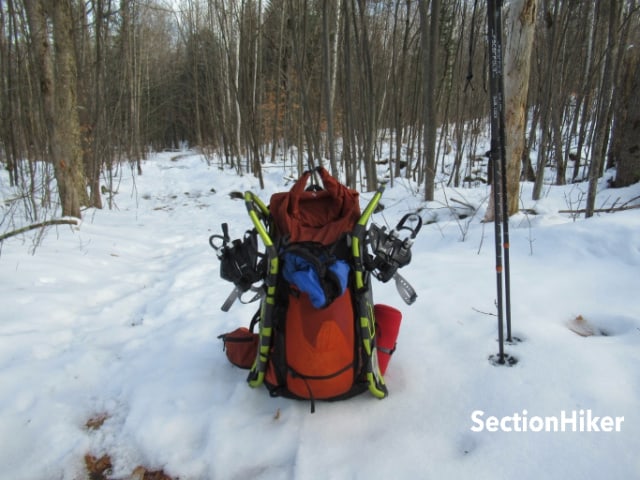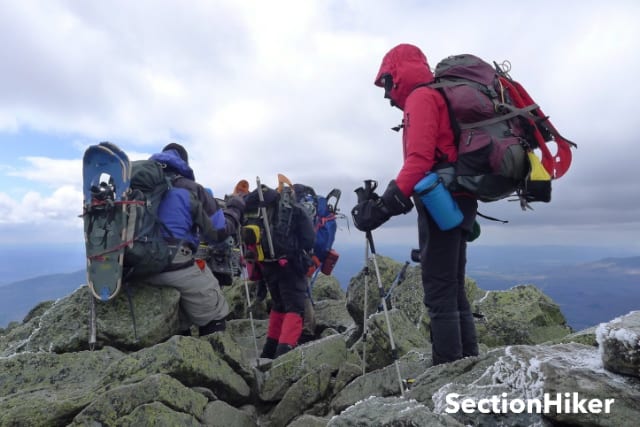There are many ways to attach snowshoes to a backpack, although some of them are more energy-efficient and comfortable than others. How you go about doing this depends on the characteristics of your backpack and the places where you can attach or carry snowshoes. For example, it is easier to carry snowshoes on backpacks that have two side compression straps, so you can slip your snowshoes underneath them when you don’t need them. If you’re shopping for a new winter backpack (see our recommended winter backpacks), it’s important to choose one that will let you carry the extra bulky winter gear you expect to need like snowshoes, crampons, skis, ice axes, or an avalanche shovel.
Let’s take a look at some examples to illustrate how you can carry snowshoes on a backpack.
Side Carry

I like to strap my snowshoes under my backpacks side compression straps because it keeps the weight on my hips and is less likely to get caught on vegetation along a trail. You really need snowshoes that have a binding system that folds flat, like the ones on MSR’s Lightning Ascent or Evo Ascent Snowshoes, so you can keep the snowshoe crampons pointing out and so they don’t cut into your backpack.

If your snowshoes have bulky bindings, which is frequently the case with snowshoes with boa binding closures, you can still attach them to the sides of your pack with the bindings facing out, but there’s a much greater risk that they’ll get snagged on vegetation. You also have to be careful with the snowshoe crampons if you use a backpack made with thinner materials, so it doesn’t slice into them.
Front Carry
There are a number of ways that you can carry snowshoes on the front of a backpack. I don’t personally like this method because the weight of the snowshoes (they usually weigh 4 to 5 pounds per pair) can pull you backward and off-balance. But it still works if that’s the only way you can attach them to your pack.

If your backpack has an open front pocket, you can slip the bottom of your snowshoes into it. You’ll still want to secure the tops of the snowshoes so they don’t fall out or sway back and forth as you walk. This method can be problematic because it can snag and rip the mesh if it comes into contact with your snowshoe’s crampons. The crampons can also punch through the body of your backpack, especially if you slip and fall onto your pack.

Some backpacks have compression straps that can connect to one another the front of a backpack, not just its sides. Granite Gear’s Crown 3 60 and Blaze 60 have this property and it makes it very convenient to attach snowshoes to the front of your pack. Deuter makes some backpacks that have this capability and many winter/mountaineering-style backpacks do as well. It’s definitely something to look out for because it can be used to connect bulky gear, including snowshoes to the front of the pack.

If your backpack doesn’t have compression straps on the side or ones that run around the front of the pack, you can usually connect elastic cord to the front of your pack to hold snowshoes. For example, many ultralight backpacks have tiny webbing loops surrounding a front mesh pocket that you can tie elastic or static cord to. I do this with backpacks from Gossamer Gear, for example. If you use static cord, you can add a cord lock to tension it.
Top Carry
If your backpack has a top lid pocket, you can usually secure your snowshoes underneath it. This can make your pack a bit top-heavy and it may make your snowshoes more susceptible to getting snagged on vegetation, but it works.

The same holds if you have a roll-top backpack, like the one in the top photo of this article. Most roll tops have a Y-strap that runs over the top and you can secure your snowshoes under it.

Conclusion
I’ve demonstrated three different ways that people attach snowshoes to their packs on winter hikes using a side carry, a front carry, and a top carry. While all of these are popular, which one you use really depends on the characteristics of your backpack (ie. compression straps, top lid, Y-strap, etc) and your snowshoes (lay-flat binding or bulking binding, sharp crampons or not). That said, winter hikers and backpackers can be quite ingenious in how they attach snowshoes to a pack. There are probably a million ways to accomplish it, so don’t feel you have to conform to the norm.
SectionHiker is reader-supported. We only make money if you purchase a product through our affiliate links. Help us continue to test and write unsponsored and independent gear reviews, beginner FAQs, and free hiking guides.
